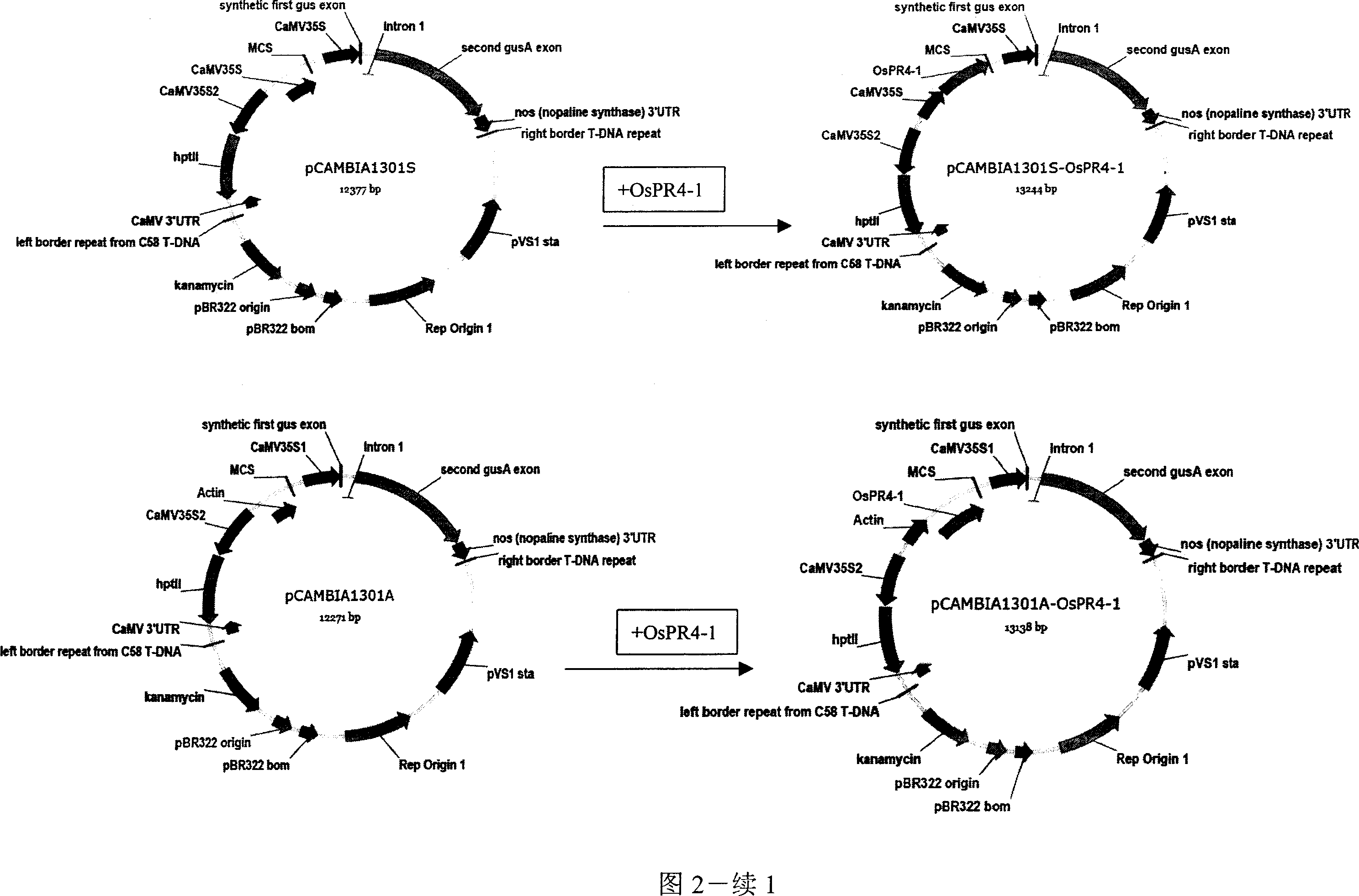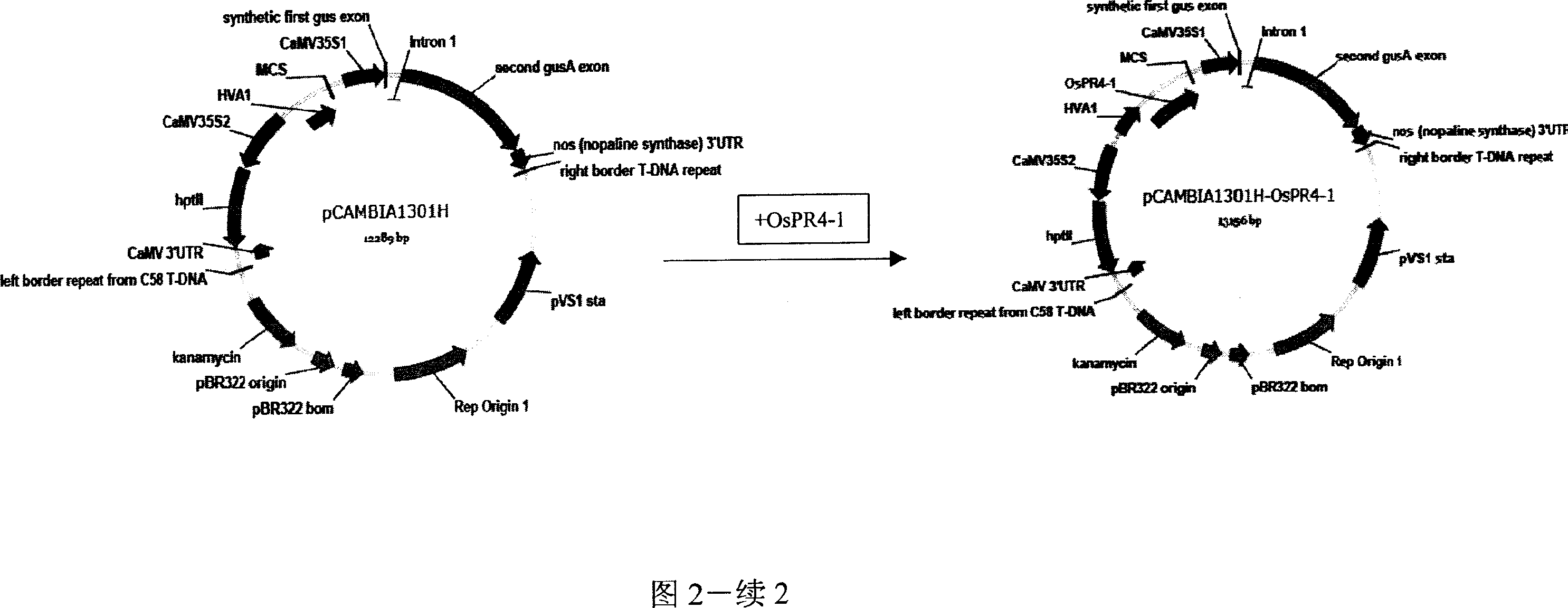Improvement of plant drought resistance by using paddy pathogenesis-related gene OsPR4-1
A plant, ability technology, applied in the field of plant biology
- Summary
- Abstract
- Description
- Claims
- Application Information
AI Technical Summary
Problems solved by technology
Method used
Image
Examples
Embodiment 1
[0022] Example 1: Isolation and cloning of DNA fragments containing OsPR4-1 gene segments and OsPR4-1 gene
[0023] Through the analysis of the drought-induced gene expression profile of the rice variety "Zhonghan 5" (a publicly used rice variety provided by the Shanghai Academy of Agricultural Sciences in China), it was found that a drought-induced gene was strongly induced (the expression level increased by 3.2 times in the late stage of drought stress) ) of EST (Expressed Sequence Signature), the gene (OsPR4-1) may be a member of the rice disease process-related protein PR4 gene family, and it is a partial sequence of the 5' end. By searching the Japanese rice full-length database (http: / / cdna01.dna.affrc.go.jp), the corresponding cDNA clone JO23075A19 was found and located on the 11th chromosome BAC clone AC137744. According to the genome sequence corresponding to OsPR4-1 in BAC clone AC137744, its promoter region was predicted, and primers PF (5-TAGGTACCGCCCATCTGCAACAGAGA...
Embodiment 2
[0025] Example 2: Detection of induced expression of rice endogenous gene OsPR4-1
[0026] The rice variety "Zhonghan 5" was used as the material, and the treatments of drought, chilling injury, high-salt stress and ABA were respectively carried out at the 3-leaf stage. The drought treatment is to soak the roots of the seedlings with 20% polyethylene glycol (trade name PEG6000, one kind), and take samples after 0h, 2h, 4h, 8h, 12h, and 24h. Chilling injury treatment is to put the seedlings in a growth chamber at 4°C, and take samples after 0h, 12h, and 24h. For high salt stress, the roots of the seedlings were soaked in 200mM / L NaCl solution and samples were taken after 0h, 8h, 12h, and 24h. For ABA treatment, the roots of the seedlings were soaked in 100 μM / LABA solution and samples were taken after 0h, 0.5h, 3h, 6h, 12h and 24h. After extracting the total RNA (Trizol reagent, Invitrogen) of the leaves, the RNA was transferred to the membrane according to the relevant exper...
Embodiment 3
[0027] Embodiment 3, construction and transformation of OsPR4-1 gene overexpression vector
[0028] According to the results of Example 2, it is known that the gene OsPR4-1 of the present invention can be induced and expressed by drought, cold damage, high salt and ABA. In order to better clarify the function of this gene, the inventor overexpressed it in rice, Verified from the phenotype of transgenic plants. The method is as follows: first, the positive clone pGEM-OsPR4-1 plasmid obtained in Example 1 is double-digested with BamHI and KpnI, and the exogenous fragment is recovered; at the same time, the genetic transformation vector pC1301S carrying different promoters is digested with the same method, pC1301A and pC1301H. After the enzyme digestion is completed, extract with chloroform:isoamyl alcohol (24:1) to purify the enzyme digestion product. The digested fragment containing the OsPR4-1 gene and the digested vector were used for a ligation reaction to transform Escher...
PUM
 Login to View More
Login to View More Abstract
Description
Claims
Application Information
 Login to View More
Login to View More - R&D
- Intellectual Property
- Life Sciences
- Materials
- Tech Scout
- Unparalleled Data Quality
- Higher Quality Content
- 60% Fewer Hallucinations
Browse by: Latest US Patents, China's latest patents, Technical Efficacy Thesaurus, Application Domain, Technology Topic, Popular Technical Reports.
© 2025 PatSnap. All rights reserved.Legal|Privacy policy|Modern Slavery Act Transparency Statement|Sitemap|About US| Contact US: help@patsnap.com



